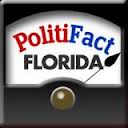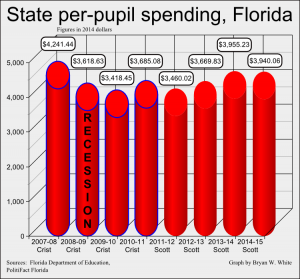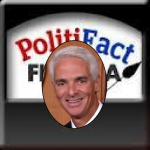 “(Charlie) Crist said Scott’s per-pupil education spending is “about $200 less” than the Crist administration did during the recession.
“(Charlie) Crist said Scott’s per-pupil education spending is “about $200 less” than the Crist administration did during the recession.
…
We rate the statement Mostly True.”
—PolitiFact Florida, from a July 18, 2014 fact check of Democratic gubernatorial candidate Charlie Crist
Overview
PolitiFact Florida’s fact check misleads on Crist’s nearly meaningless claim.
The Facts
On July 18, 2014, PolitiFact Florida fact checked an education spending claim from Democratic gubernatorial candidate Charlie Crist. PolitiFact Florida said Crist made the claim during an interview with the Tampa Bay Times’ editorial board:
In one freewheeling discussion with the Tampa Bay Times editorial board July 16, 2014, former Gov. Crist attacked Scott’s education spending.
“I can only imagine how nice it would be to serve as governor when you have a surplus of almost $3 billion. That’s what this guy has right now,” Crist said. “And in spite of it, he still hasn’t matched what I did during the recession for per-pupil funding for kids. In fact, he’s about $200 less.”
PolitiFact Florida said per-pupil spending under Crist in 2007-2008 was almost $200 more than for Gov. Scott’s 2014-2015 budget, but noted Crist signed that budget before the recession started. PolitiFact Florida adjusted the per-pupil funding figures for inflation and said per pupil funding was higher under Crist than under Scott. PolitiFact Florida rated Crist’s claim “Mostly True,” defined as “The statement is accurate but needs clarification or additional information.”
Analyzing the Rhetoric
PolitiFact Florida puzzled us with this fact check. A number of questions occurred to us while reading it.
Why did PolitiFact give Crist a pass for his apparent attempt to compare nominal-dollar figures, with no inflation adjustment, using a cherry-picked year preceding the recession? Why didn’t PolitiFact narrow its examination to the lone true recession year during Crist’s term, 2008-2009? Why did PolitiFact do its comparisons for per-pupil spending including federal and local government contributions?
“About $200 less”
PolitiFact Florida tried to check Crist’s claim that his recession-era per-pupil education spending was about $200 greater than Scott’s peak. The only figure PolitiFact found that approximated the $200 difference came by using Crist’s 2007-2008 budget, which preceded the recession. The recession officially started in December 2007. Florida’s fiscal year runs from July 1 to June 30 of the following year, so the 2007-08 budget, fiscal year 2008, was nearly six months underway before the recession started.
Are we supposed to believe Crist foresaw the recession and budgeted accordingly? That doesn’t seem reasonable to us. If Crist was comparing his 2007-08 budget to Scott’s budgets then he’s cherry-picking his peak spending and passing it off as what he spent during the recession.
If we’re comparing nominal dollars and comparing Crist’s per-pupil spending to Scott’s, then Crist’s 2008-09 budget fills the bill. The problem? Crist’s nominal per-pupil spending in 2008-09 was $91 less than Scott’s budgeted figure for 2014-15.
Crist gets a “Mostly True” rating from PolitiFact Florida for a failed comparison using nominal dollars.
PolitiFact Florida to the Rescue
With Crist’s claim of a $200 spending advantage in trouble, PolitiFact threw out Crist’s nominal-dollar comparison and replaced it with inflation-adjusted dollars (bold emphasis added):
However, these numbers don’t account for inflation. If they did, that 2007-08 number would equal $8,176 in 2014 dollars, $1,200 more than what is currently budgeted per student.
Even at the lowest spending during Crist’s tenure in 2009-10, the inflation-adjusted total in state and local funding would be around $7,209, still a higher value than Scott’s last budget.
This reasoning implies Crist underestimated how much more he spent than Scott. PolitiFact Florida appears to justify the truth of Crist’s claim by focusing on his underlying point, that he spent more per-pupil than Scott.
We think it’s reasonable to prefer comparisons using inflation-adjusted dollars. But we question allowing Crist to take credit for education funds raised and allocated locally or federally.
 The State’s Share of Per-student Spending
The State’s Share of Per-student Spending
Is it reasonable to include local education spending when touting education spending at the state government level? We think circumstances may call for consideration of local spending. But we don’t see much justification for it in this case. Crist specifically said “(Scott) still hasn’t matched what I did during the recession for per-pupil funding for kids.” It’s already a stretch for Crist to take credit for state education funding allocated through the state legislature. We don’t see any justification for Crist to take credit for local education spending.
Looking only at inflation-adjusted state education spending changes the picture. We calculated state spending as a percentage of total education spending, then used those percentages to figure the amount of state spending per pupil. The graph to the left tells the story. State spending during Crist’s recession year fell short of per-pupil spending under Scott for each year except for Scott’s first year in office. Scott exceeded Crist’s level of funding from the recession year by $51.20 in his second year, $336.60 in his third year and $321.43 in his fourth-year budget. Crist’s average per-pupil spending was less than Scott’s average over four years, excluding local and federal funding.
Is It Right to Include Local and Federal Spending?
We expect some may object to our exclusion of federal and local funding for state K-12 education. We think our explanation above serves as an adequate justification, but we can claim added support through an article PolitiFact Florida cited from the Miami Herald and written by the Tallahassee bureau chief of the Tampa Bay Times, Steve Bousquet. Bousquet’s June 2, 2014 story on Scott’s new budget downplayed Scott’s per-pupil education spending increase by pointing out that much of it came from local sources (bold emphasis added):
The bottom-line number for K-12 schools of $20.7 billion is the largest in history, but per-pupil spending is still $177 less than during the high-water mark of 2007-2008, the first year of former Gov. Crist, Scott’s likely opponent this fall.
In addition, about two-thirds of the increase in K-12 spending is paid for by local property taxes, due to increases in home values — one of several indicators of a rejuvenated Florida economy.
We think looking at funds coming directly from the state government serves as the best measure of the state government’s willingness to fund education. To the extent the governor can take credit for state education spending, the state government spending, excluding federal and local contributions, likewise serves as the best measure.
Summary
PolitiFact Florida prematurely stopped its digging into this story. Excluding local and federal contributions to the Florida education budget, Rick Scott exceeded per-pupil spending under Crist during the 2008-2009 recession year for the past three years.
“Scott’s per-pupil education spending is “about $200 less” than the Crist administration did during the recession.”
PolitiFact Florida says it is true that per-pupil education spending was higher during the recession under Crist than under its current governor. PolitiFact Florida obtains that result by ignoring Crist’s attempt to make his comparison in nominal dollars, and magnifies the one-sidedness of its fact check by giving Crist credit for local education spending. In terms of per-pupil education spending by the state government, Scott has exceeded Crist’s recession-year spending in each of the last three years.
PolitiFact Florida left out some important parts of the story, and we find the fact check contains a fallacy of one-sidedness.
PolitiFact Florida turns Crist’s pumpkin into a horse-drawn carriage with its “Mostly True” rating.
Additional note
It’s certainly worth pointing out that high education spending doesn’t necessarily correlate with favorable education outcomes.
References
Gillin, Joshua. “Rick Scott’s Student Spending Is ‘about $200 Less’ than during Recession, Charlie Crist Says.” PolitiFact Florida. Tampa Bay Times, 18 July 2014. Web. 25 July 2014.
Gillin, Joshua. “PolitiFact Florida: Charlie Crist Touts Per-pupil Spending vs. Rick Scott.” Tampa Bay Times. Tampa Bay Times, 20 July 2014. Web. 25 July 2014.
“State of Florida’s Budget.” Flcourts.org. Florida Courts, n.d. Web. 25 July 2014.
Isidore, Chris. “It’s Official: Recession since Dec. ’07.” CNNMoney. Cable News Network, 01 Dec. 2008. Web. 25 July 2014.
“Report: Recession Over In June 2009.” NPR. NPR, 20 Sept. 2010. Web. 25 July 2014.
Derby, Kevin. “Charlie Crist Celebrates Florida Getting Race to the Top Funds.” Sunshine State News. Sunshine State News, 24 Aug. 2010. Web. 25 July 2014.
“Florida Education Finance Program (FEFP).” Myfloridahouse.gov. Florida House of Representatives, 2010. Web. 25 July 2014.
“Florida Education Finance Program (FEFP).” Online Sunshine. The Florida Legislature, 2001. Web. 25 July 2014.
Gibson, William E. “$1.3B from Federal Stimulus Will Give Florida a Boost.” Orlando Sentinel. Orlando Sentinel, 10 Aug. 2010. Web. 25 July 2014.
Patrick, William. “Less Is More in Florida Education Spending.” Watchdog.org. Franklin Center for Government & Public Integrity, 31 May 2013. Web. 25 July 2014.







